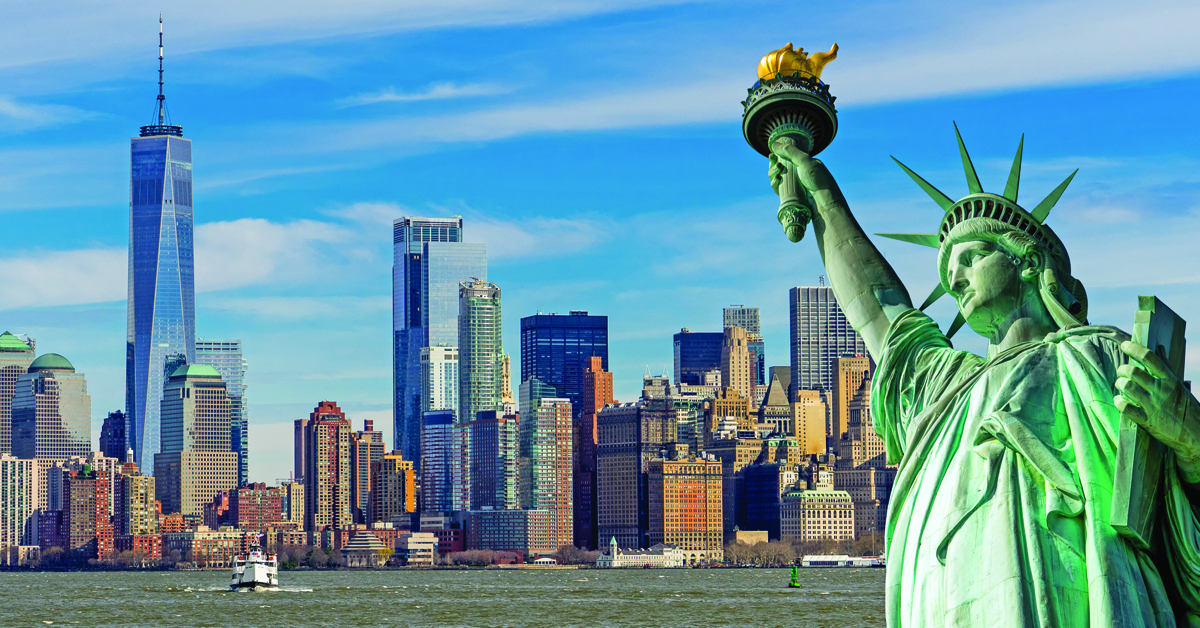In 1791, Alexander Hamilton founded the first Bank of the United States in Philadelphia. Although it would last only 20 years (and its successor another 20), it established the Mid-Atlantic Region as the economic powerhouse that it remains today.
Many of America’s banks and financial-services companies now operate about 100 miles north on Wall Street. Outside New York City, the Mid-Atlantic states of Delaware, New Jersey, New York and Pennsylvania function as centers of business, history, technology and industry.
These states are still recovering economically from the COVID-19 pandemic and had relatively high unemployment rates as of July 2022. New York’s and Delaware’s unemployment rates were the highest in the region at 4.4%, followed by Pennsylvania at 4.3% and New Jersey at 3.7%. Although still high compared to the rest of the nation, unemployment rates have steadily declined in all four states since their peak in early 2020.
After strong gross domestic product (GDP) gains in 2021, the region’s GDP shrank in first-quarter 2022, following the trend set by the rest of the nation. The pressures of high inflation have hit the Mid-Atlantic states, but inflation in this region is lower than the country’s as a whole, softening this past April to about 7%.

Delaware is well known for its business-friendly taxes and courts, and more than 1.8 million U.S. businesses are legally registered there. In fact, Delaware has more incorporated businesses than residents. New Jersey is an industrial and tourism capital, boasting some 2,500 advanced manufacturers and 130 miles of idyllic, boardwalk-studded coastline.
Founded as one of the original 13 colonies, Pennsylvania is an epicenter of American history. Philadelphia, where Hamilton established the first U.S. bank, also hosted the first and second Continental Congresses along with the signing of the Declaration of Independence, and the city is home to the Liberty Bell. The state established itself as a steel and coal powerhouse during the Industrial Revolution and continues to serve as a manufacturing capital.
New York boasts the country’s largest city, with the New York City metro-area population topping 20 million in 2020. Outside the city, upstate New York is a recreational haven, home to Niagara Falls, the Finger Lakes, and the Adirondack and Catskill mountains.
This past July, New York state officials approved one of the largest real estate projects in Ameri-can history: a roughly $7 billion redevelopment of Penn Station in New York City and its immediate surrounding area. The station, which sits underneath Madison Square Garden, has been a focus of commuter complaints for some time, according to The New York Times.
The redevelopment would renovate the station to include larger underground passageways, new entrances, more natural light and a new plaza outside the station. The plan also calls for the construction of 10 new towers around the station, which would deliver an estimated 18 million square feet of office and retail space, 1,800 residential units and a hotel. ●

Manhattan office-using employment rose to 1.5 million in the second quarter of this year, only 6,500 jobs below the February 2020 peak, according to a Cushman & Wakefield market report. Office leasing activity fell in the second quarter to 5.9 million square feet, down from the average of 7.3 million square feet in the previous two quarters.
Year to date, however, leasing activity had soared in comparison to Q2 2021, rising from 5.9 million to 13.1 million square feet. Major lease renewals in Q2 2022 included Tiffany & Co.’s 287,000-square-foot deal on Fifth Avenue and Blackstone Group’s expansion from 100,000 to 300,000 square feet along Lexington Avenue.
The quarter also saw three major construction deliveries: 50 Hudson Yards, 1245 Broadway and 124 East 14th Street. Together, these new deliveries brought more than 1 million square feet of vacant space to the Manhattan market, contributing to an increase in the overall vacancy rate (which reached 21.5%).
Focus: Shipping industry
The Port of New York and New Jersey is the largest on the East Coast, handling about $200 billion worth of cargo and millions of cruise passengers every year. Goods shipped into the port travel by rail and truck as far as Illinois, Tennessee and parts of Canada. But much of the cargo stays within a four-hour drive of the port, a radius that is home to 46.3 million people.
About 100 miles south, the Delaware River ports of Philadelphia and Wilmington also serve millions of people and create thousands of jobs. Shipping operations in these major Northeast hubs account for roughly 450,000 jobs (directly and indirectly), including longshoremen, truck drivers, rail workers and more.
Like other ports, these shipping hubs have seen increased volumes and bottlenecks during the pandemic. The Port of New York and New Jersey introduced new tariffs this past September to reduce congestion while preventing both empty and loaded shipping containers from sitting in the port.
What the locals say
“The hot cities right now are surprisingly the second-tier cities that were not highly sought after by investors just a few years ago. Areas like Harrisburg, York and Allentown, Pennsylvania, have seen more growth over the last 10 years than any others that I could think of. This new construction and growth has investors from NYC, D.C., and throughout the U.S. focusing on these markets now, which is driving values to all-time highs. We are still seeing a lot of folks moving out of Philadelphia and into the suburbs. The new-construction apartment properties in the suburbs are doing really well.”

Corey Lonberger
Managing partner
Rittenhouse Realty Partners
3 Cities to Watch
Wilmington

Delaware’s largest city is about 20 miles downriver from Philadelphia and is home to roughly 70,000 people. Known as the “Corporate Capital of America,” a single building in this small city is home to 300,000 business entities that call Wilmington home — on paper — because of Delaware’s business-friendly tax laws and courts. This includes major corporations such as Google, Apple, eBay, Walmart, American Airlines and Verizon.
Albany

New York’s capital city has been around longer than the United States. Originally settled by the Dutch, Albany’s city charter was granted in 1686 under English rule. Now sprawling across upstate New York, Albany’s metro area (which includes neighboring cities Troy and Schenectady) is home to 1.1 million people. The capital region is home to a burgeoning tech industry, the Rensselaer Polytechnic Institute and the State University of New York Polytechnic Institute.
Pittsburgh

Pennsylvania’s second-largest city lies at the confluence of three rivers. With its unique topography of rivers, valleys and steep hills, early European settlers had trouble navigating the region. Now, more than 250 years after its founding, Pittsburgh is home to 446 bridges — more than any other city in the world. Ten Fortune 500 companies are headquartered in Pittsburgh, including U.S. Steel and PNC Financial Services.
Sources: Albany.com, Bloomberg, Britannica.com, Business Insider, Choose New Jersey, City of Philadelphia, CNBC, Cushman & Wakefield, Delaware Division of Corporations, Discover Upstate New York, Empire State Development, Federal Reserve Bank of St. Louis, Federal Reserve History, History.com, Pittsburgh Post-Gazette, Port of New York and New Jersey, Port Authority of New York, Rochester Democrat and Chronicle, State of Delaware, Visit New Jersey, Visit Wilmington, Wilmington Office of Economic Development, WPXI-TV
Author
-

Hannah Darden is the former industry rankings editor at Scotsman Guide Inc.
View all posts




